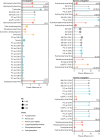Exposing 24-hour cycles in bile acids of male humans
- PMID: 39562795
- PMCID: PMC11576969
- DOI: 10.1038/s41467-024-53673-9
Exposing 24-hour cycles in bile acids of male humans
Abstract
Bile acids are trans-genomic molecules arising from the concerted metabolism of the human host and the intestinal microbiota and are important for digestion, energy homeostasis and metabolic regulation. While diurnal variation has been demonstrated in the enterohepatic circulation and the gut microbiota, existing human data are poorly resolved, and the influence of the host circadian system has not been determined. Using entrained laboratory protocols, we demonstrate robust daily rhythms in the circulating bile acid pool in healthy male participants. We identify temporal relationships between bile acids and plasma lipids and show that these relationships are lost following sleep deprivation. We also highlight that bile acid rhythmicity is predominantly lost when environmental timing cues are held constant. Here we show that the environment is a stronger determinant of these temporal dynamics than the intrinsic circadian system of the host. This has significance for the intimate relationship between circadian timing and metabolism.
© 2024. The Author(s).
Conflict of interest statement
Figures




References
-
- Thaiss, C. A. et al. Transkingdom control of microbiota diurnal oscillations promotes metabolic homeostasis. Cell159, 514–529 (2014). - PubMed
-
- Thaiss, C. A. et al. Microbiota diurnal rhythmicity programs host transcriptome oscillations. Cell167, 1495–1510.e12 (2016). - PubMed
-
- Zheng, X. et al. Hyocholic acid species improve glucose homeostasis through a distinct TGR5 and FXR signaling mechanism. Cell Metab.33, 791–803.e7 (2021). - PubMed
Publication types
MeSH terms
Substances
Grants and funding
- BB/W00139X/1/RCUK | Biotechnology and Biological Sciences Research Council (BBSRC)
- BB/N005953/1/RCUK | Biotechnology and Biological Sciences Research Council (BBSRC)
- BB/I019405/1/RCUK | Biotechnology and Biological Sciences Research Council (BBSRC)
- BB/I019405/1/RCUK | Biotechnology and Biological Sciences Research Council (BBSRC)
- BB/I019405/1/RCUK | Biotechnology and Biological Sciences Research Council (BBSRC)
LinkOut - more resources
Full Text Sources

